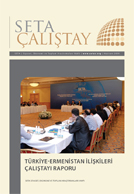SETA PUBLIC LECTURE By Ali T. Akarca Department of Economics, University of Illinois at Chicago Chair Talip Küçükcan SETA Date: June 23, 2009 Tuesday Time: 16.00 – 18.00 Venue: SETA Foundation, Ankara
Abstract:
The outcome of the 29 March 2009 Turkish local administrations election is analyzed in two ways. First, the nationwide vote share of the incumbent party (AKP) is compared to what would be expected based on the patterns observed in the past twenty-six National Assembly, Senate, and Provincial Council elections held between 1950 and 2007. For this purpose a vote equation is estimated using aggregate time-series data, which takes into account the role played by economic conditions, incumbency factors, strategic voting by the electorate, and the post-2002 political realignment process. Second, inter-party vote movements between the 2007 parliamentary and the 2009 local administrations elections are analyzed, through systems of party vote equations, estimated separately for different regions of the country, utilizing cross-provincial data. The results obtained show that the outcome of the 2009 election can be explained and was predictable on the basis of historical patterns. The vote loses of the AKP is attributable mainly to the poor economic conditions and the typical strategic-voting in local elections. The voters who deserted the AKP went to the DP, SP and DTP, in the middle-east and south-east, and to the MHP and SP, in the rest of the country.








